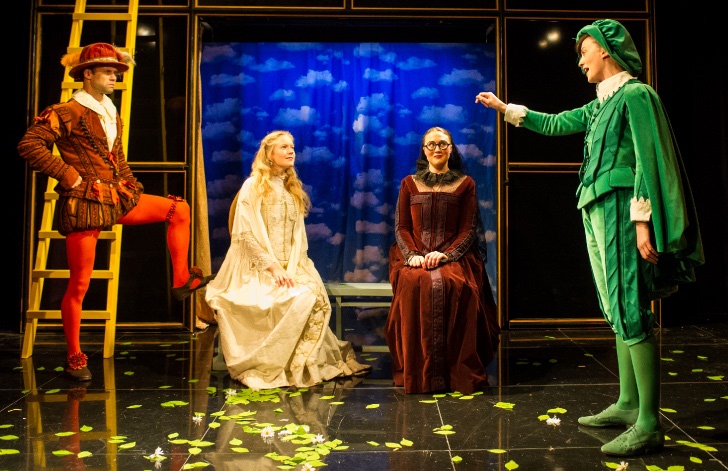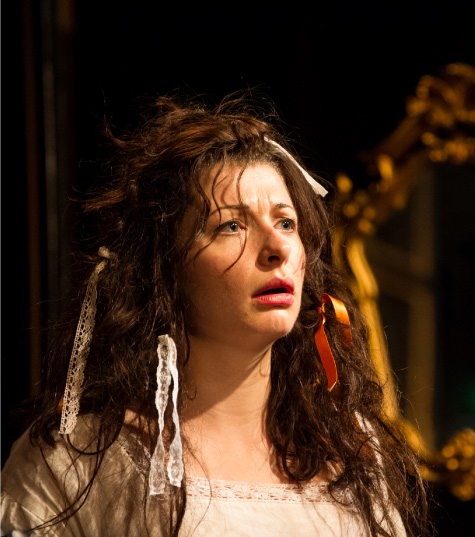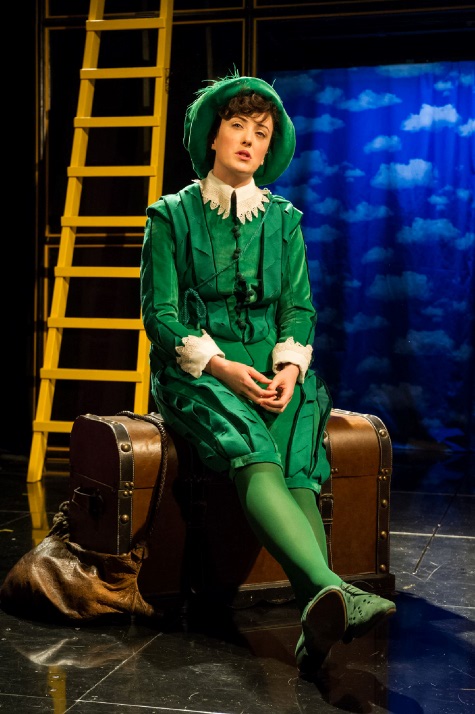|
A hoard of Spanish treasure

Simon Scardifeld (Don Juan), Katie Lightfoot
(Dona Ines), Dona Clara (Katie Hemingway) and Heddydd Dylan (Don
Juana/Don Gil)
Spanish Golden Age
Belgrade Theatre B2, Coventry
*****
THIS is
a Golden Age for the Belgrade Theatre. Watching a play on the theatre’s
B2 Studio stage is almost comparable to a visit to the Swan at
Stratford.
Yet
nothing prepared me for the extraordinary excellence and ingenuity of
its coproduced ‘Spanish Golden Age’ Season – three plays by grandees of
the Elizabethan (or I guess one should say Philippic) era of Hispanic
drama: by Shakespeare’s almost exact contemporary Lope de Vega
(1562-1635); and the impressively long-lived Tirso de Molina
(c1579-1648), who lasted through to the end of the Thirty Years’ War.
These three sizzling stagings
we owe to the Belgrade, to East London’s innovative Arcola Theatre
(dubbed ‘an undisputed powerhouse’ by Time Out), and to Bath’s
Theatre Royal (more often, like Malvern, a major receiving house for
dramas en route to the London stage). You would have thought a box
office risk, but no: Coventry’s evening and matinee audiences were
respectable in numbers and eager in anticipation.
It’s heartbreaking to think
this sensational ensemble of ten actors will shortly be broken up and
disperse. My first taste of them here was the one tragedy among the
three dramas, Lope de Vega’s Punishment without Revenge. I came
away reeling.
What hits one is not just the
company’s stage glitter but the brilliant ingenuity of Vega’s writings,
captured here in a top drawer translation by Meredith Oakes (each of the
three, one tragedy and two comedies, although the Spanish were keen to
intermingle the two genres, has a different translator: Sean O’Brien for
Don Gil de las Calzas Verdes; David Johnston for La Dama Boba).
Yet for all its dark power and
arch repartee, in some ways this scintillating tragedy is not
quite Shakespeare. Punishment without Revenge centres round a
randy, reformed Duke of Ferrara (William Hoyland, rather a benign old
cove in all three), who plans to land the dukedom on his illegitimate
son, but is outdone by popular opinion and manipulating political
pressures. He takes a young wife, wherewith to sire a new heir, only to
find his young bastard is more to her taste (a case of the biter bit).
The gory dénouement
sees him almost coolly (hence the title) arrange for the judicial murder
of both. Suppressing anger and jealousy, he simply exercises merciless
law.
Shakespeare, at any stage of
his career, would have furnished more plot diversions and undercurrents,
and eloquent speeches whose imagery goes far beyond Vega’s, to wrench expectations and render the outcome sharper, bitterer. Nor is
the Spaniard’s treatment here as bald as, say, Marlowe or Webster. The
accompanying comedies show that the Spaniards come closer, perhaps, to
Ben Jonson.
to wrench expectations and render the outcome sharper, bitterer. Nor is
the Spaniard’s treatment here as bald as, say, Marlowe or Webster. The
accompanying comedies show that the Spaniards come closer, perhaps, to
Ben Jonson.
Yet powerful stuff it is.
There were some obvious gems in this production of El Castigo Sin
Venganza (1631). One was Simon Scardifoot, who as the hapless bag
carrier Batin (aide to Nick Barber’s vividly characterised, believably
erotic Federico, the bastard) creates a character somewhere between
Baldrick and Lord Percy of Blackadder.
The wonderful Frances McNamee as
Finea in A Lady Of Little Sense
Yet Scardifoot is subtler: in
two of these plays (less so in Don Gil) he generates a host of
little half gestures and anticipatory flickers and after-flutters,
half-started then half-ended utterances, that are like a dictionary of
comic mastery.
When he drops his voice he
sometimes allows witticisms to get lost; but most you get. Munching,
blinking, twitching, scratching, whining, huffing and puffing, shifting
from foot to foot, playing up as Federico’s servant acting the Duke’s
fool, he is very, very funny, as well as polished, poignant,
sympathetic.
The company’s most notable
wonder is actress Frances McNamee. Subtle, sharp, edgy, versatile,
snappy in comic roles, searing in tragedy, you’d have though the RNT or
RSC would have grabbed her by now. They should certainly make a beeline
for her.
On Mark Bailey’s simple,
tapestried or mirror-backed Hispanic set, and in his superb take on
early Jacobean costume, she looks good every time; she commands a stage
effortlessly. She can do the sensual and intimate and confidential as
easily as she does noblesse and regal hauteur. Vocal and
insuppressible, when her Cassandra acts appalled, she shivers you in
your boots: ‘Are you in love with some bronze image or alabaster nymph?’
Her outburst on women’s role as a chattel in the house – and the
proto-feminism with which Vega lets her dismiss it, was classic: a clear
enunciation of woman’s role as the real power behind, or even in front
of, the throne.
Yet the Duke’s speech early on
is pure Shakespeare: Hoyland plays broadly the same benign tall
figure in all three plays, and speaks his lines – one long monologue ‘My
mother was called Laurentia’ for instance - in an endearing old-school
way. Honourably, tediously noble. Curiously, it is (I think) he who
argues in this play that marriage ‘should be a matter of taste’, not
merely arranged (as his is).
The support cast delivers
well, but it was Chris Andrew Mellon (Ricardo and Rutilio), here as in
the other plays, who slightly upped the quality of the speaking. Katie
Lightfoot produced an aptly irritable and ambitious Aurora, the vexed
niece; she can shrew for England
(or perhaps Iberia).
The Lope de Vega comedy, A
Lady of Little Sense, again directed with visionary control and
flair by the Theatre Royal, Bath Studio’s (and formerly Gate Theatre’s)
Laurence Boswell, sees McNamee play an extraordinary role as the
supposed marriageable halfwit who is in fact the shrewdest, most
intellectual of them all.
As she wantonly flips from her
newly acquired assurance to and fro from her flighty and provocative
former self (a teenager, in fact), bewilderi ng
all around her with crazy stares and two year old tantrums, the effect
is hilarious. But also disconcerting. And disarming. ng
all around her with crazy stares and two year old tantrums, the effect
is hilarious. But also disconcerting. And disarming.
This was an utterly magnetic
performance, riddled with aplomb, rendering A Lady of Little Sense
(La Doña Boba)
arguably the best of the three.
Scardifield was again the
second treat. The comedy – servant and master, etc. - is virtually
Plautine, its quick-fire witticisms certainly up to Shakespeare; and
whatever the role or character type, he brings it to life in his own
inimitable way – jealous suitor, put-upon bag-carrier, muttering,
hapless, pouting victim of his own misjudgments.
Hedydd Dylan
in Don Gil of the Green Breeches
He does a private line in
poignancy; and helplessness; the result is helplessly funny. He splits
sides by introducing us to the word – and the concept of – ‘unhugging’.
His whole act seems to build up (for me, seeing the plays in that order)
to where he is revealed hiding under a table in Don Gil.
Blackadder again - a complete nitwit.
Jim Bywater – soon to appear,
and triumph, in Don Gil in the important servant role – here does
a nice little vignette as the tutor who thinks he can tame this
Katharina/Shrew but soon gets worsted.
Doug Rao flourishes in all
three plays – semi-inventive but utterly sound - as the suave, would-be
suitor who is not quite as clever as he thinks. Scene after brilliant
scene is sensationally, nattily well directed by Boswell, who has
acquired in his leads (someone’s fine auditioning or casting) some
particularly intelligent, and adroit performers.
Somehow you sense all the time
in this nifty, never-misses-a-trick production that there’s some sort of
spoof going on; and invariably there is. But it’s never overloaded. A
joke, a sly moment, an in-your-face surprise comes and goes, to be
replaced by something quite contrasting. It’s a masterpiece of pacing.
Again, Ben Jonson comes to mind: The Epicene, The Devil is an
Ass, and so on.
It was noticeable there was
virtually no music – at least, background music – in A Lady of Little
Sense. A good decision. That for Punishment without Revenge
(a kind of indeterminate original score from Jon Nicholls) struck me as
a bit of a hodge-podge, and ineffective, though perhaps no worse than
your average Stratford.
His levels as Sound Designer
were rather good throughout, however; and if you yearned for some
Spanish Golden Age music – Victoria, or Morales – in the tragedy, you
got it in Don Gil, which included some unbelievably melting music
of the period, beautifully chosen and aptly pitched. And to
differentiate the three plays was almost certainly a good idea.
Ben Ormerod’s lighting effects
were subdued but masterly. He had a knack of picking out quite complex
or angular blockings, two or three people at a time, to strongest
effect. The restrained use of cyclorama and colour effects within the
rearstage entry channel invariably impacted well. Some of his scene
changes were gratifyingly slick, helping the pace of all three plays
immensely.
The third play, Don Gil of
the Green Breeches, is the one not by Lope de Vega but by Tirso de
Molina (best known for El Burlador de Sevilla (the original
Don Juan),
The Upside-Down Republic,
and so on). Molina, unlike Vega, did not enlist and serve in Philip II’s
Spanish Armada against England!
If the dramatic impact here
(in Don Gil de las Calzas Verdes) was less, it was partly due to
the more routinely zany nature of the plot (girl seeks to retrieve her
errant lover by adopting a series of disguises), even though, as the
superbly full programme notes explain, ‘Tirso takes some of the common
ingredients of Golden Age comedy as it had developed under the tutelage
of Lope de Vega, and pushes them beyond the normal, formal limits….In a
complex, ambitious farce the main actress leads the audience to the edge
of comedy, almost to the point of no return (girl becomes boy becomes
girl in a – as Gide had it - mise-en-abîme:
as if in a series of mirrors).’
What it did have was a
terrific lead. RADA-trained Hedydd Dylan had already caught the eye with
a brilliant series of vignettes as the maid Clara, a mischievous aide
and support to Francis McNamee’s Finea, the feisty teenager of A Lady
of Little Sense. Here as Doña Juana, posing as the supposed Don Gil
in violent swathes of Lincoln Green (at one point late in the play no
less than four characters - not all of them male - appear in the same
attire, in a bid to claim they are Don Gil), Dylan was pure
delight.
LESS SECURE
However there seemed a less
secure directorial hand, even though the Arcola’s founder, Mehmet Ergen,
was at the helm, and this slightly cost her (and the men, who at times
looked pathetically underdirected). Had the same kind of precision and
variety that marked her Clara been present here, or had her own
sharp-witted invention been on a par with McNamee’s (who provided a
frumpy maid without stealing the show), Dylan would have solved the
problem of the saminess of some of the scenes. Paradoxically, she did
really well in Juana/Gil’s Tempest-like set-piece exposition at
the outset. The fun never lapsed, she held the stage magnificently, she
has beautifully canny ways of rounding off a gesture or casting a
knowing look over her shoulder, and in one scene she was a dead ringer
for Trinculo discovering Stephano and Caliban: very funny. When she
redresses as a Spanish lady, confusing all by her similarity to the
green boy, it makes for shiveringly good theatre.
She was also suitably boyish
(‘the Don of love is just a boy’ goes together with several sly
allusions by others to ‘his’ relative pricklessness); but directorially
the story and pacing and overall presentation still slowed and limped in
places. She manages the emerging chaos (‘This is a mess’) brilliantly,
even if at times it’s just a bit too much like watching Julie Andrews in
Pantomime.
What Ergen did to his credit
achieve was drawing out their best performances (in the three plays)
from both Katie Lightfoot (as the aspiring Doña Ines) and Annie
Hemingway (as the impossible suitor Doña Clara, a sort of maroon-clad
Joanna Lumley-offshoot). Nick Barber, the splendid Federico from
Punishment without Revenge, pulled off the role of servant (Ossorio)
with aplomb; Scardifield found new ways of recycling his old tricks as
the incompetent and bungling (and most unlikely-named) Don Juan, who
actually ends up getting his girl (Ines).
What did this trilogy prove,
apart from the genuinely inspired skills of this patched together acting
team, the dramatic punch of its main leads, and the calibre of the
Arcola-Bath Theatre Royal-Belgrade direction and staging?
It showed how in early 17th
century Spain the role of women was, or could be, amazingly
liberated; how the Hispanics had as fine a gift as ours for playing the
fool; how they were not afraid of mocking and parodying moneyed or
haughty or jumped-up aristocracy; how they raised questions of different
perceptions across the generations; and how servants could impudently
wisecrack, effortlessly outwit their masters, rule the roost, advise
their bosses what to do and abet them in their antics. This is indeed
the comedy of Aristophanes, of Plautus-cum-Shakespeare (The Comedy of
Errors), of Da Ponte (Don Giovanni-Leporello).
Or as Jonathan Thacker’s note
on Don Gil puts it, ‘What is it that makes Don Gil, an invented
character played by a woman, more attractive than the other men in the
play? What do “his” actions tell us about social roles and expectations?
Is a more moral, just society out of the question?’
Above all, it showed that the
70-plus full length plays of Molina, and the well over a hundred dramas
of Vega, if these be anything like typical, are a serious omission from
the English stage. We need to see more of them. And we will clearly be
the better for it.To 19-04-14.
Roderic Dunnett
|

